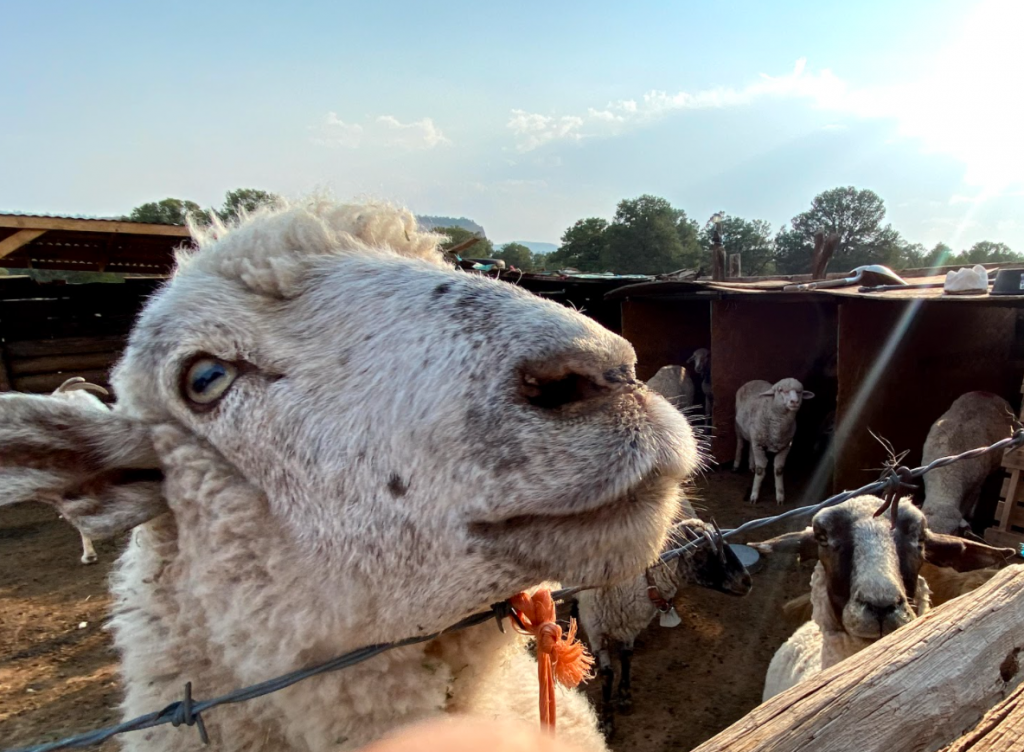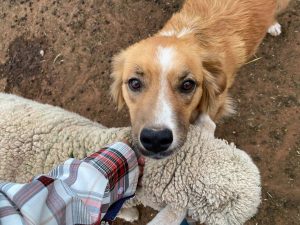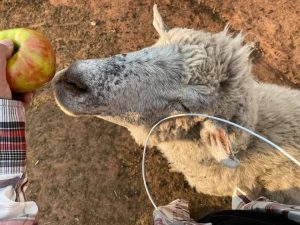Yá’át’ééh ‘abiní. The 7 Generation Games design team finished the first phase of Making Camp Navajo, which included brainstorming, drafting, and outlining cultural scripts and mini-games.

Throughout our first phase, we were accompanied by our wonderful and highly knowledgable Dine’ cultural consultants, Albert B. Chase of Dine’ Pollen Trail Consulting, Michelle Whitstone, a Canada-based cultural consultant who helped develop Navajo Rosetta Stone, and Geneva Johnson, longtime educator and culture education consultant. Don’t forget Jeremy D. Arviso of RVSO DSGN. He joined the 7 Generation Games design team as a game artist. His Photoshop animation art features a lineup of all-new characters, animals, and landscapes to be deployed within Making Camp Navajo and its lesson resources. Their breadth of Dine’ cultural knowledge, research, and creative contributions are what help make this project possible. Onward!
The windy road home
Over the weekend, I had taken a measly Frontier flight home to the Navajo Nation from SeaTac. I had been nervous in the weeks leading up to my trip back to Tohatchi, even though I had been Covid-vaccinated. I pulled through the lazy, red-eye flight from SeaTac to Denver without any issues, and finally had a happy reunion with my parents at the Sunport in Albuquerque, New Mexico. We ate breakfast along Central Avenue and visited Old Town, where we bought some chili candy and ice cream. We then stopped to get a Laguna burger on the way home (these are fresh, made-to-order burgers topped with hot green chili).
Upon arriving to Gallup, we were greeted by a sandstorm that blocked out the sunlight. This symbolized hardship for me in my mind by reminding me of everything our Dine’ people had gone through in the past year: the pandemic, the resulting disconnection between students and their access to education, droughts, wildfires… it had me worried.
At the same time, the sandstorm was also an old and familiar sight, because of our Dine’ traditions and stories surrounding wind. Why? Wind is a force of nature that is associated with Navajo oral tradition. Our creation stories speak of winds that breathed life into new creations. The wind is what comes before the rain. Wind heralds the rain. It is what fans the fires. It moves pollen from point A to point B. At the same time, it can bring destructive forces. It knocks homes down. Whatever wind helped you start your fire is now either blowing it out or spreading it to a field where it whooshes out of control. I’m reminded of my weaving teacher’s lessons. He told us the week before that there are male and female elements in everything. Right now, the wind is stretching out a long journey home into what seems a lifetime. By the time I get to Tohatchi, I feel I have finally left Seattle behind for good. I’m in my homelands.
Twin Buttes
I settled in easily as Tohatchi was quiet and free of distractions. I had scripts to work on, newsletters to write, and a presentation to prepare for in the coming week. Come what may, I said to myself, I will work hard to help our team bring Making Camp Navajo to life. I decided to end the day with a field trip to our family’s flock in Twin Buttes, near Navajo, NM.

It had been almost a year and a half. I saw many new, wooly faces. My parents told me about the ones we lost, either to those awful feral dogs or bloat. As I fed them slices of honeycrisp apples I had bought them from the Window Rock Basha’s, I felt myself bonding with them. I began figuring out what to do about their corral (How can we make it easier to catch them for vaccinations this week?), their runny noses (Are they sick?), and the drought they were enduring (They are unusually peckish and scrambling after every last bit of hay and apple morsel).
After a moment, I caught myself reflecting on my great-grandma and her daughters, my paternal grandma and my great-aunts, and their lives. They had bartered for this land, post-Long Walk. I thought about what it took for my great-grandma to watch one of her daughters, my grandma Rose Barney Hanson, be forced from her care into the Fort Wingate boarding school on horseback, led away by a government official. What did that feel like, watching your youngest daughter ride away, growing smaller and smaller, out of your family homelands, into an unknown future? For my great-grandmother, times were changing in the 1930s and many tough decisions had to be made.

It was the flock who brought me back to the present. “Fuzzy,” a wether marked as our “forever lamb,” nibbled and untied my shoelaces on one boot, reminding me that I had to think about the present. Fuzzy’s relatives needed hay. They need their hooves trimmed. They need water every day. They need their vaccines too.
I took mental note of the absence of horses from our family “ranch.” Herding them without horses means that we have to walk with them. I silently hoped I wouldn’t step into a prairie dog burrow and fall down, looking like a total “noob” herder in my thirties. My grandma probably learned to herd sheep as soon as she could keep up with everyone. I still have a lot to learn, but I think I have safely made a friend in The Fuzz, albeit with apple slices. I really hope I don’t let The Fuzz down. Navajo people have a saying, likely cultivated after centuries of toiling after sheep, that if you take care of your sheep, your sheep will take care of you.
I sincerely hope it is true.
Stay tuned for more Behind the Scenes blog posts from Christy Hanson as she chronicles Making Camp Navajo!

This is a good read. Storying is an important part of expressing the cultural. It has expressive, descriptive and most important (in my valuing cultural writing) an affective realm providing a real world experience for the reader.
Your photos with expressive statements provided me some previous insight.
I agree with you about the importance of story telling. I think that is one reason many games and many math curriculum are not effective, they just throw problems and information out with no context and no story by which to engage learners and tie new information with what students already know.
‘Ahehee’ laa for stopping by, Dr. Pepion! I have heard a lot of family stories since returning, many of which I have heard many times before. I feel oral tradition storytelling extends from ceremonial traditions to heirloom stories about the family ancestors, to everyday tales.
Teaching young people agriculture involves math, ELA, and even our traditional and contemporary knowledge of our sheep and our tribe’s relationship with these animals and our herding practices. We have three Suffolk sheep who are fiercely independent (they run away and don’t return until sundown), but have colorful personalities and readily accept hay and treats from strangers. The Merinos allow themselves to be herded, and have puffy, wooly coats and wrinkled faces. They are both distinct from Navajo-Churro, the heritage breed that had previous been introduced and cultivated here on the Navajo Nation. This was the social studies aspect of our sheep ownership and it begged quite a number of questions” “What is the history of Navajo-Churros on the Navajo Nation from 1500 to 2020?” “Would Navajo-Churros be a good breed choice for Southwestern sheep farmers? Why or why not?” “What grazing permits exist on the Navajo Nation for both sheep and goats?”
So, I found that high-quality sheep health resources provide the scientific name of the bot fly whose larvae causes runny noses, and how to treat it. In vaccinating our sheep, we had to do some online research. In administering the oral medication, we had to carefully measure out each dose for each adult sheep and weaning lambs by estimating their weight, which is usually relative to age. We used math to calculate this, along with calculating how much dewormer to buy at the “sheep store.”
Meanwhile, the uncles consumed enough breakfast calories that morning to power themselves up. Their breakfasts may have consisted of two cups of black coffee each at 0 calories, one tortilla each at 129 calories, a slice of mutton each at about 364 calories. This was followed by fried potatoes at 323 calories per serving. Estimate how many calories they consumed in all.
All these problems naturally arise in sheep care. Navajos have a saying: “T’aa hwo ‘ajit’eego,” which means, “It’s up to you.” How can a learner solve this problem? This involves thinking, planning, implementation, and reflection/ resilience, a four step path toward solving a problem using this Dine’ philosophy. Having just implemented our dewormer plan, we hope the medicine takes effect and that everyone feels more comfortable in their corral soon, and we as the herders feel more resilient. Those who are still learning, like myself, can use this experience to guide one’s own Sheep Learning Path for the future, using reflection, while again starting at the beginning. This process, as I applied it, is considered to be cyclical.